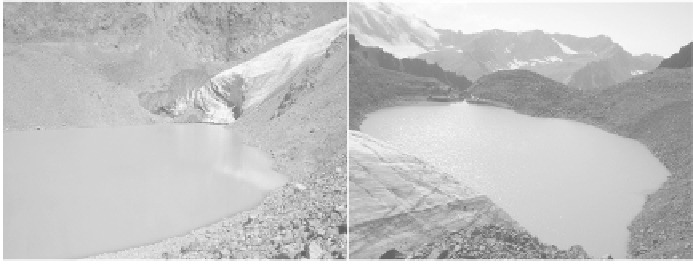Geoscience Reference
In-Depth Information
Identiϔication of Potentially Dangerous Glacial Lakes (PDFLs) based on
the interconnectivity of systems
An integrated assessment is required for the identifi cation of potentially
dangerous glacial lakes in an automated and objective way. Bolch et
al. (2011a) suggest to combine the conditioning parameters based on a
numerical approach on the basis of additive ratio scales similar to those
used in business studies (Kahle 1998). The aim is to have an effi cient tool
for decision making. In this case, this approach helps to ascertain which
lakes are potentially of high danger and should be further investigated.
Each introduced variable has to be tested if it applies to the investigated
lake. If so (e.g., if a potential ice avalanche would reach a lake or a lake
is in direct contact to the glacier), a value of one is assigned to the lake
(otherwise a zero). This approach is, however, not applicable for lake area
and lake growth. Usually a larger lake area contains more water and can
therefore cause higher damage. Bolch et al. (2011a) introduced three size
classes (small, medium, large) and assigned the factors of 0.5, 1 and 1.5 to
each lake according to its area. Lake growth was treated in a similar way.
In contrast to reality, for easy modelling the applied variables should
be independent. As already mentioned above this is practically not the
case: For example, the increase of lake area depends at least partly on
the glacier retreat, if a lake is in direct contact to the glacier. Glacier-fl ow
velocity and slope (below 5°) are also not independent. These two issues
can be considered while assigning the weighting factors to each variable.
A weighting scheme is also needed in order to account for the different
impacts on the potential danger of the lakes investigated. However, the
weighting is at least partly subjective, depends also on the special situation
in the study are and should hence be done by an expert.
Bolch et al. (2011a) suggest a weighting scheme after a sequential order
of the parameters, as this is most objective and each variable is treated
Figure 14.6.
Highly dangerous lake No. 6 in Kishi Almaty (Malaya Almatinka) valley after the
surface lowering by deepening of the outfl ow channel in 2010 (left view from dam to glacier,
right view to dam, photos: V. Blagoveshchenskiy).


Search WWH ::

Custom Search